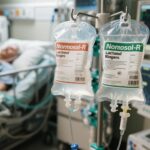Background
Chronic kidney disease (CKD) and type 2 diabetes (T2D) share a complex and detrimental relationship, significantly increasing patient morbidity and mortality worldwide. Progressive kidney damage in these patients often culminates in end-stage renal disease and increased cardiovascular (CV) risk. Therapeutic advances targeting both renal and cardiac outcomes remain critical to improving patient prognosis. Finerenone, a selective nonsteroidal mineralocorticoid receptor antagonist (MRA), and sodium-glucose cotransporter 2 inhibitors (SGLT2is), such as empagliflozin, have each demonstrated efficacy in slowing CKD progression and reducing adverse CV events in patients with T2D. The CONFIDENCE trial (NCT05254002; EudraCT 2021-003037-11) investigates whether their combined early use offers superior albuminuria reduction, a surrogate marker for CKD progression, compared to monotherapy.
Study Design
CONFIDENCE is an international, multicenter, randomized, placebo-controlled, double-blind Phase 2 trial designed to evaluate the additive effect of finerenone plus empagliflozin on reducing urine albumin-to-creatinine ratio (UACR) over six months. The trial enrolled 818 adults aged 18 years and older with CKD and T2D, defined by an estimated glomerular filtration rate (eGFR) between 30 and 90 mL/min/1.73 m2 and UACR between 100 and 5000 mg/g. Inclusion required stable renin-angiotensin system inhibitor therapy at maximum tolerated doses for over one month prior to screening. Participants were randomized (1:1:1) into three arms receiving either finerenone plus empagliflozin, finerenone plus placebo, or empagliflozin plus placebo, administered once daily. Empagliflozin was dosed at 10 mg daily, while finerenone dosing (10 or 20 mg daily) was adjusted based on baseline eGFR. Randomization was stratified by baseline eGFR (850 mg/g). The primary endpoint is the relative change in UACR from baseline at Day 180.
Baseline Clinical Characteristics
Participants were diverse, recruited from 143 sites across 14 countries. The mean eGFR was 54.2 mL/min/1.73 m2 (SD 17.1), indicating moderate CKD on average. Median UACR was 583 mg/g (IQR 292–1140), with significant albuminuria burden. Glycemic control was moderate, with a mean HbA1c of 7.3% (SD 1.2). The mean systolic/diastolic blood pressures were 135.2/77.3 mmHg. Notably, 23% and 39% of participants were on glucagon-like peptide-1 receptor agonists and insulin, respectively, reflecting varied background diabetes management. Cardiovascular comorbidities were common: 28% had atherosclerotic cardiovascular disease (ASCVD), 16% had diabetic retinopathy, and 4% had a history of heart failure.
Key Findings and Implications
While final outcome data on UACR reduction and clinical efficacy are pending, the baseline attributes underscore a patient cohort at meaningful risk for progressive kidney and cardiovascular complications. This heterogeneity in clinical profile — including differing degrees of renal impairment, albuminuria severity, and usage of concomitant antihyperglycemic therapies — enhances the trial’s generalizability to real-world populations with CKD and T2D.
The rationale for combining finerenone with an SGLT2i rests on their complementary mechanisms: finerenone blocks mineralocorticoid receptor-mediated inflammation and fibrosis, while SGLT2 inhibitors promote glycosuria, natriuresis, and hemodynamic benefits. Previous studies independently showed significant kidney and CV benefits from each. CONFIDENCE will clarify if early combination therapy yields additive or synergistic reduction in albuminuria, potentially translating into improved renal and cardiovascular protection.
Expert Commentary
Leading nephrology and endocrinology specialists highlight the importance of this trial given the unmet needs in CKD management among T2D patients. Dr. Rajiv Agarwal, a principal investigator, emphasizes that “the early combination approach targets two distinct pathogenic pathways simultaneously, which may improve outcomes beyond what is achievable with single-agent therapy.” However, experts also caution about safety considerations such as hyperkalemia risk with MRAs and volume depletion with SGLT2 inhibitors — areas to be carefully monitored in the study.
Conclusions
The CONFIDENCE trial successfully enrolled a robust and representative cohort of CKD patients with T2D to evaluate the efficacy of combination finerenone and empagliflozin therapy on albuminuria reduction. This study will provide critical evidence on whether combined mineralocorticoid receptor antagonism and SGLT2 inhibition initiated early can better mitigate CKD progression and improve cardiovascular outcomes compared to current standard treatments. Pending results could influence clinical guideline updates and patient management strategies worldwide.
References
Agarwal R, Green JB, Heerspink HJL, Mann JFE, McGill JB, Mottl AK, Rosenstock J, Rossing P, Vaduganathan M, Brinker M, Edfors R, Li N, Scheerer MF, Scott C, Nangaku M; CONFIDENCE investigators. COmbinatioN effect of FInerenone anD EmpaglifloziN in participants with chronic kidney disease and type 2 diabetes using a UACR Endpoint (CONFIDENCE) trial: baseline clinical characteristics. Nephrol Dial Transplant. 2025 Aug 1;40(8):1559-1569. doi: 10.1093/ndt/gfaf022. PMID: 39916475; PMCID: PMC12315800.



